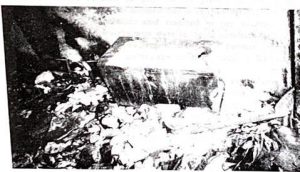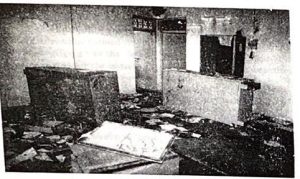Guru Nanak (1469-1539 A. D.), founder of the Sikh faith, visited Bidar on his way to Ceylon around 1510. Ever since this ancient town appears to have supported a small but conspicuous Sikh society. Guru Gobind Singh (1666-1708 A.D.), the 10:h guru, paid much attention to these Sikhs. One of the “Five Beloved Ones,” that is the very first five initiates into the order of Khalsa namely Bhai Sahib Singh hailed from this town. During his last days he sent Mai Bhago, one of the spiritually elevated Sikhs of her time, to settle at Janwada (aout 10 kms from Bidar) to preach Sikhism.
The sweet water spring (Jheera) around which the main Sikh shrine (gudwara) is built came to be again effectively controlled by the Sikhs as late as 1950. Development of the place began with renewed vigour. Sikh attention was also focused on it siacea similar place of worship (Panja Sahib) became a part of the new-born Pakistan and access to which was restricted. Most Sikhs came to regard the town as a substitute for Panja Sahib making it a big centre of pilgrimage.
The offerings of pilgrims at Nanak Jheera steadily increased. The management was encouraged to undertake certain social welfare measures for the betterment of the people of Bidar. It built the following institution:
1) Guru Nanak Hospital now with 500 beds was founded in 1969. It continues to provide free medical aid to the sick of all communities.
2) Guru Nanak Public School was started in 1975. It has 1500 students on its rolls of whom 1454 are non-Sikhs.
3) Guru Nanak Dev Engineering College _ started functioning on August 8, 1980, Admission to this college has not been refused to any local student who applied for it, The non-Sikh percentage of students here is 57.
4) Guru Nanak Dev Polytechnic having 60 present Sikh students was set up in 1986.
5) Guru Nanak Dev Pre-University College started functioning this year.
Altogether about 600-700 Sikh students of the above mentioned institutions, mainly those of Engineering College, were victims of the present attacks on the Sikhs at Bidar.
This small (population : a little more than 1 lakh) ancient town, housing these and several other institutions, was rocked by looting, arson, mayhem and murder. It continued for at least four days beginning September 14, 1988 and left a deep ugly scar on the minds of Sikh people as the victims were exclusively Sikhs. The impact of happenings was great. It sent shock waves throughout the Sikh world 45 students from all over the country were studying at Bidar. News of concern and protest poured in daily. Brutal nature of happenings was particularly noted with grave concern.
A great deal thus already appeared in the Press before the Punjab Human Rights Organization decided to send its Chairman, Mr Justice A.S. Bains, a retired Judge of the Punjab and Heryana High Court, to Bidar to probe into the matter. Mr. Bains was assisted and accompanied by Mr. Gurtej Singh, a former Indian Administrative Service Officer, who had at one time served in adjoining Medak district of Andhra Pradesh, and had acquaintance with the area and its people.
The team landed at Hyderabad on September 29, 1988 and discussed the Bidar incidents with local Sikhs including an engineer, a doctor and a businessman. The team continued the discussions the next morning with a couple of civil servants also joining in, Thereafter it recorded the statement of the still-dazed Kuldip Singh (18) making 4 miraculous recovery from nearly a dozen stab wounds in the local hospital. It also talked to his father and the doctors who bad first attended on him and others
Thereafter the team set out by road for Bidar which is 134 kilometers from Hyderabad. About four kilometers from Bidar its vehicle was stopped by a posse of policemen who thoroughly searched the vehicle. The luggage of the driver and the team was opened up and given a thorough check up. The persons of the occupants were frisked with hand held metal detectors This degrading welcome was projected by the morning papers to all Sikhs entering the town that day. The team went Straight to the main shrine and saw it thickly surrounded by the police. Policemen in uniform were freely moving about in the premises of the gurdwara.
Rest of the day was spent in interviewing people, recording their statements, gathering information and in discussions. Amongst those interviewed were a few officials, gurdwara and College management people, some local politicians, social workers and students This went on till late at night and was resumed early next day when discussions were also held with the police top brass. The team also visited the sites of the incidents. Several Press clippings were collected and many photographs showing destruction were obtained. A Press conference was also held by the team. People interviewed were generally found to be cooperative and communicative except for the officials who would not say much in public in view of the impending enquiry by a High Court Judge, This sort of work was continued on the next day by Justice A. S. Bains, Some of those interviewed, however, requested anonymity. Before and after the visit several students who have returned to Punjab and Chandigarh from Bidar were also interviewed and their statements were recorded.
The Police did not allow the team to proceed to Janwada. It provided security to the point of annoyance. It must, however, be mentioned that the DIG promptly withdrew the rude police intruders from the gurdwara permises once the team mentioned to him that they were serving no useful purpose as they many times outnumbered the peaceful pilgrims engaged in worship.
Raju Gadgi, a goonda of Bidar who led mob to loot and arson residences of the Sikh students.
This is what is lelt of Sikh students after the incidents.

